Analyzing Asset Impairment Under AASB 136 and IFRS Standards
VerifiedAdded on 2020/05/28
|10
|1597
|262
AI Summary
This analysis delves into the principles outlined in AASB 136 concerning the impairment of assets, specifically excluding inventories. The assignment examines how these standards apply to goodwill and other non-inventory assets within a business's financial statements. Key components include assessing the method for determining impairment losses and their subsequent allocation among various asset classes, such as patents, buildings, fittings, and goodwill. A practical example is provided, showcasing how impairment loss on a Cash Generating Unit (CGU) should first be charged to goodwill up to its carrying amount before being proportionally distributed across remaining assets based on their respective values. The analysis also contrasts these procedures with International Financial Reporting Standards (IFRS), highlighting compliance considerations and implications for European accounting practices as per the referenced studies.
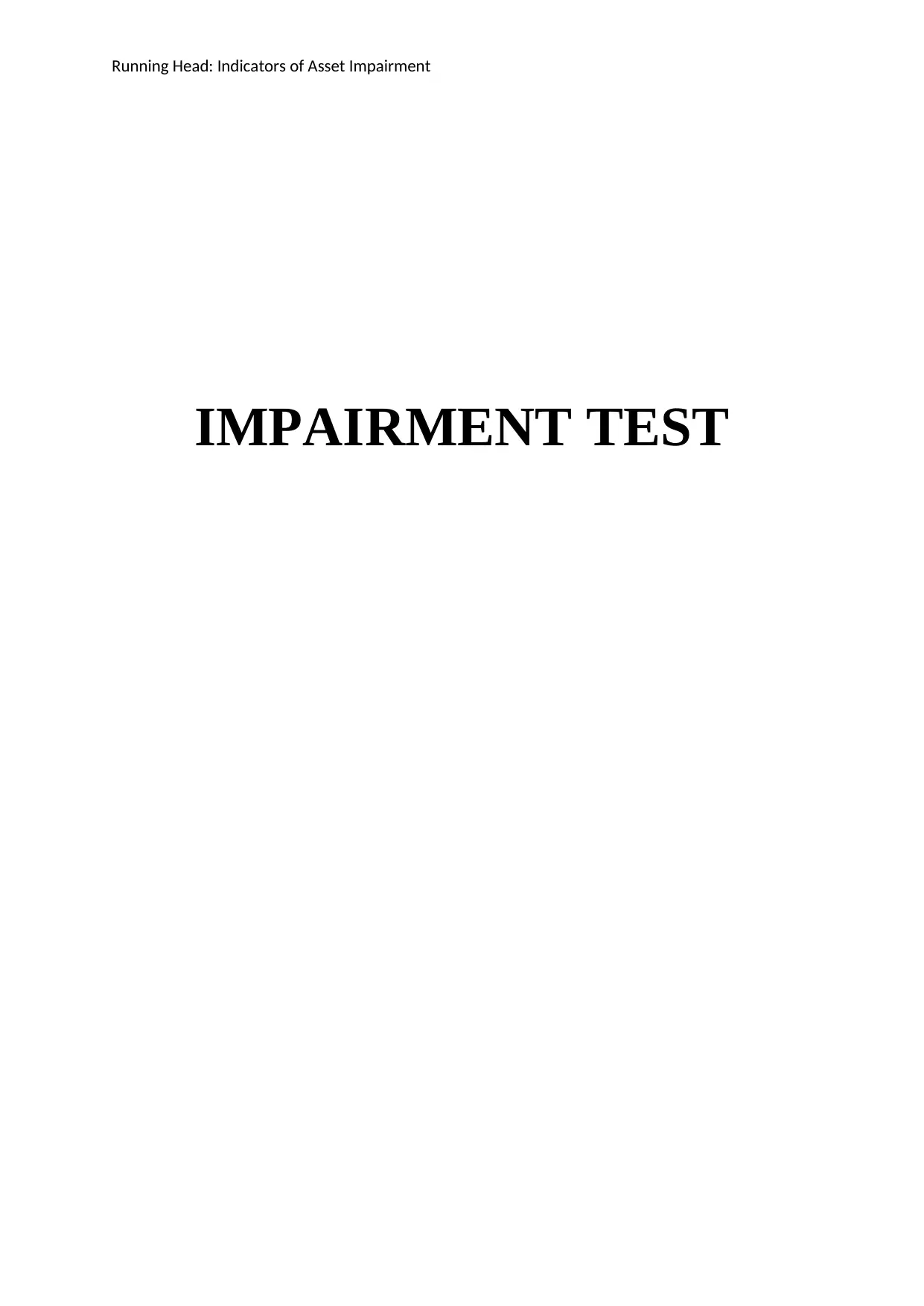
Running Head: Indicators of Asset Impairment
IMPAIRMENT TEST
IMPAIRMENT TEST
Paraphrase This Document
Need a fresh take? Get an instant paraphrase of this document with our AI Paraphraser
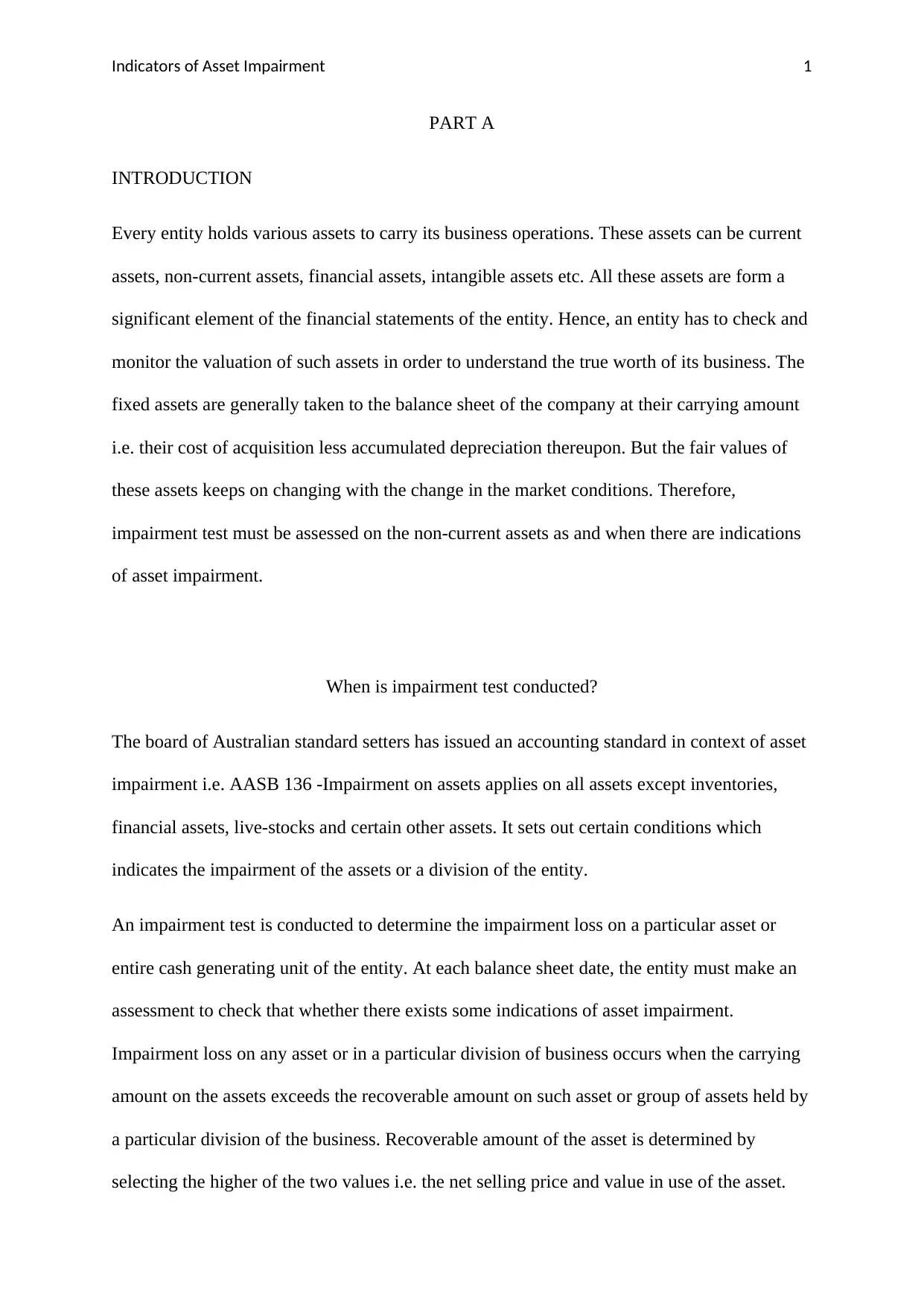
Indicators of Asset Impairment 1
PART A
INTRODUCTION
Every entity holds various assets to carry its business operations. These assets can be current
assets, non-current assets, financial assets, intangible assets etc. All these assets are form a
significant element of the financial statements of the entity. Hence, an entity has to check and
monitor the valuation of such assets in order to understand the true worth of its business. The
fixed assets are generally taken to the balance sheet of the company at their carrying amount
i.e. their cost of acquisition less accumulated depreciation thereupon. But the fair values of
these assets keeps on changing with the change in the market conditions. Therefore,
impairment test must be assessed on the non-current assets as and when there are indications
of asset impairment.
When is impairment test conducted?
The board of Australian standard setters has issued an accounting standard in context of asset
impairment i.e. AASB 136 -Impairment on assets applies on all assets except inventories,
financial assets, live-stocks and certain other assets. It sets out certain conditions which
indicates the impairment of the assets or a division of the entity.
An impairment test is conducted to determine the impairment loss on a particular asset or
entire cash generating unit of the entity. At each balance sheet date, the entity must make an
assessment to check that whether there exists some indications of asset impairment.
Impairment loss on any asset or in a particular division of business occurs when the carrying
amount on the assets exceeds the recoverable amount on such asset or group of assets held by
a particular division of the business. Recoverable amount of the asset is determined by
selecting the higher of the two values i.e. the net selling price and value in use of the asset.
PART A
INTRODUCTION
Every entity holds various assets to carry its business operations. These assets can be current
assets, non-current assets, financial assets, intangible assets etc. All these assets are form a
significant element of the financial statements of the entity. Hence, an entity has to check and
monitor the valuation of such assets in order to understand the true worth of its business. The
fixed assets are generally taken to the balance sheet of the company at their carrying amount
i.e. their cost of acquisition less accumulated depreciation thereupon. But the fair values of
these assets keeps on changing with the change in the market conditions. Therefore,
impairment test must be assessed on the non-current assets as and when there are indications
of asset impairment.
When is impairment test conducted?
The board of Australian standard setters has issued an accounting standard in context of asset
impairment i.e. AASB 136 -Impairment on assets applies on all assets except inventories,
financial assets, live-stocks and certain other assets. It sets out certain conditions which
indicates the impairment of the assets or a division of the entity.
An impairment test is conducted to determine the impairment loss on a particular asset or
entire cash generating unit of the entity. At each balance sheet date, the entity must make an
assessment to check that whether there exists some indications of asset impairment.
Impairment loss on any asset or in a particular division of business occurs when the carrying
amount on the assets exceeds the recoverable amount on such asset or group of assets held by
a particular division of the business. Recoverable amount of the asset is determined by
selecting the higher of the two values i.e. the net selling price and value in use of the asset.
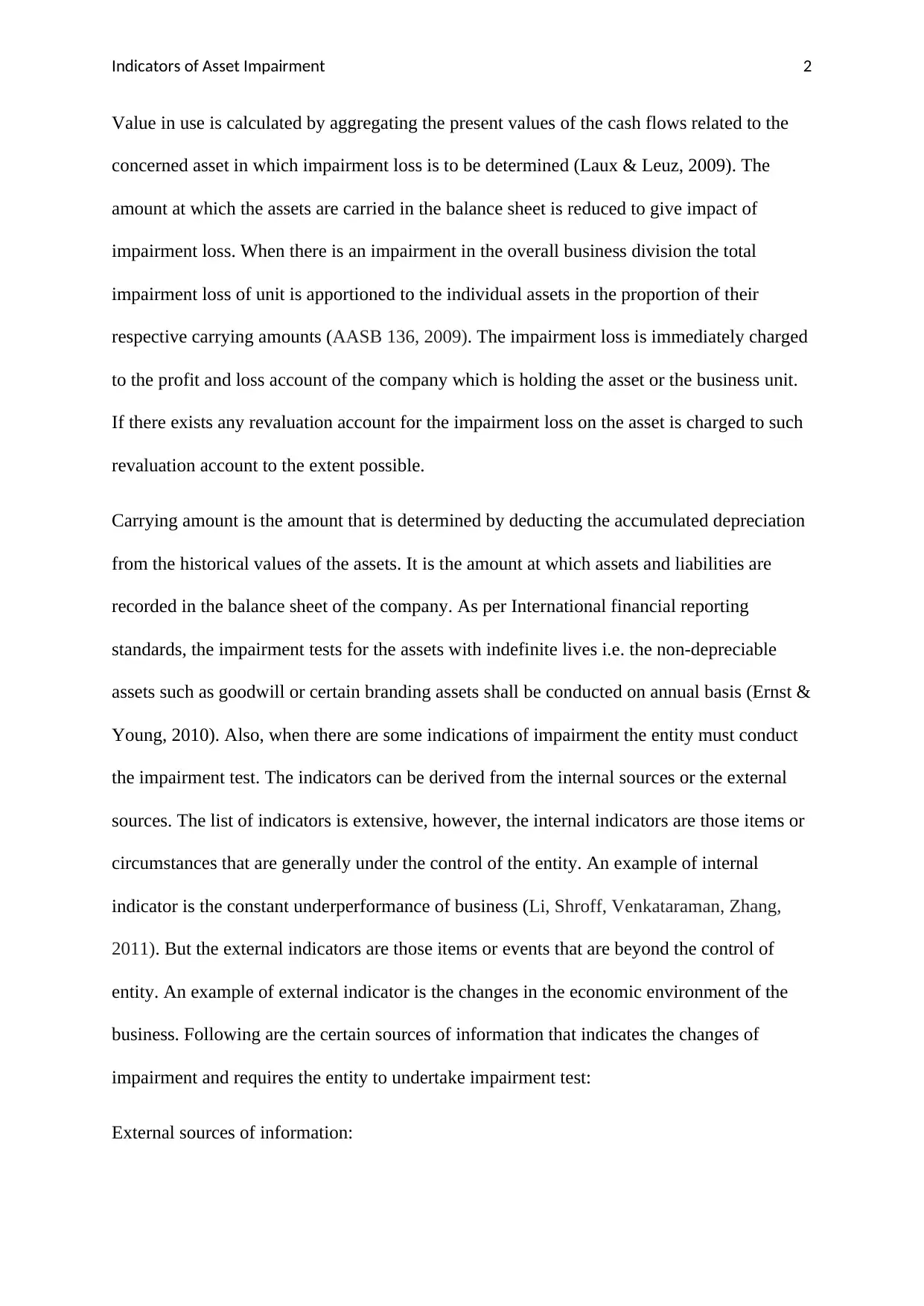
Indicators of Asset Impairment 2
Value in use is calculated by aggregating the present values of the cash flows related to the
concerned asset in which impairment loss is to be determined (Laux & Leuz, 2009). The
amount at which the assets are carried in the balance sheet is reduced to give impact of
impairment loss. When there is an impairment in the overall business division the total
impairment loss of unit is apportioned to the individual assets in the proportion of their
respective carrying amounts (AASB 136, 2009). The impairment loss is immediately charged
to the profit and loss account of the company which is holding the asset or the business unit.
If there exists any revaluation account for the impairment loss on the asset is charged to such
revaluation account to the extent possible.
Carrying amount is the amount that is determined by deducting the accumulated depreciation
from the historical values of the assets. It is the amount at which assets and liabilities are
recorded in the balance sheet of the company. As per International financial reporting
standards, the impairment tests for the assets with indefinite lives i.e. the non-depreciable
assets such as goodwill or certain branding assets shall be conducted on annual basis (Ernst &
Young, 2010). Also, when there are some indications of impairment the entity must conduct
the impairment test. The indicators can be derived from the internal sources or the external
sources. The list of indicators is extensive, however, the internal indicators are those items or
circumstances that are generally under the control of the entity. An example of internal
indicator is the constant underperformance of business (Li, Shroff, Venkataraman, Zhang,
2011). But the external indicators are those items or events that are beyond the control of
entity. An example of external indicator is the changes in the economic environment of the
business. Following are the certain sources of information that indicates the changes of
impairment and requires the entity to undertake impairment test:
External sources of information:
Value in use is calculated by aggregating the present values of the cash flows related to the
concerned asset in which impairment loss is to be determined (Laux & Leuz, 2009). The
amount at which the assets are carried in the balance sheet is reduced to give impact of
impairment loss. When there is an impairment in the overall business division the total
impairment loss of unit is apportioned to the individual assets in the proportion of their
respective carrying amounts (AASB 136, 2009). The impairment loss is immediately charged
to the profit and loss account of the company which is holding the asset or the business unit.
If there exists any revaluation account for the impairment loss on the asset is charged to such
revaluation account to the extent possible.
Carrying amount is the amount that is determined by deducting the accumulated depreciation
from the historical values of the assets. It is the amount at which assets and liabilities are
recorded in the balance sheet of the company. As per International financial reporting
standards, the impairment tests for the assets with indefinite lives i.e. the non-depreciable
assets such as goodwill or certain branding assets shall be conducted on annual basis (Ernst &
Young, 2010). Also, when there are some indications of impairment the entity must conduct
the impairment test. The indicators can be derived from the internal sources or the external
sources. The list of indicators is extensive, however, the internal indicators are those items or
circumstances that are generally under the control of the entity. An example of internal
indicator is the constant underperformance of business (Li, Shroff, Venkataraman, Zhang,
2011). But the external indicators are those items or events that are beyond the control of
entity. An example of external indicator is the changes in the economic environment of the
business. Following are the certain sources of information that indicates the changes of
impairment and requires the entity to undertake impairment test:
External sources of information:
⊘ This is a preview!⊘
Do you want full access?
Subscribe today to unlock all pages.

Trusted by 1+ million students worldwide
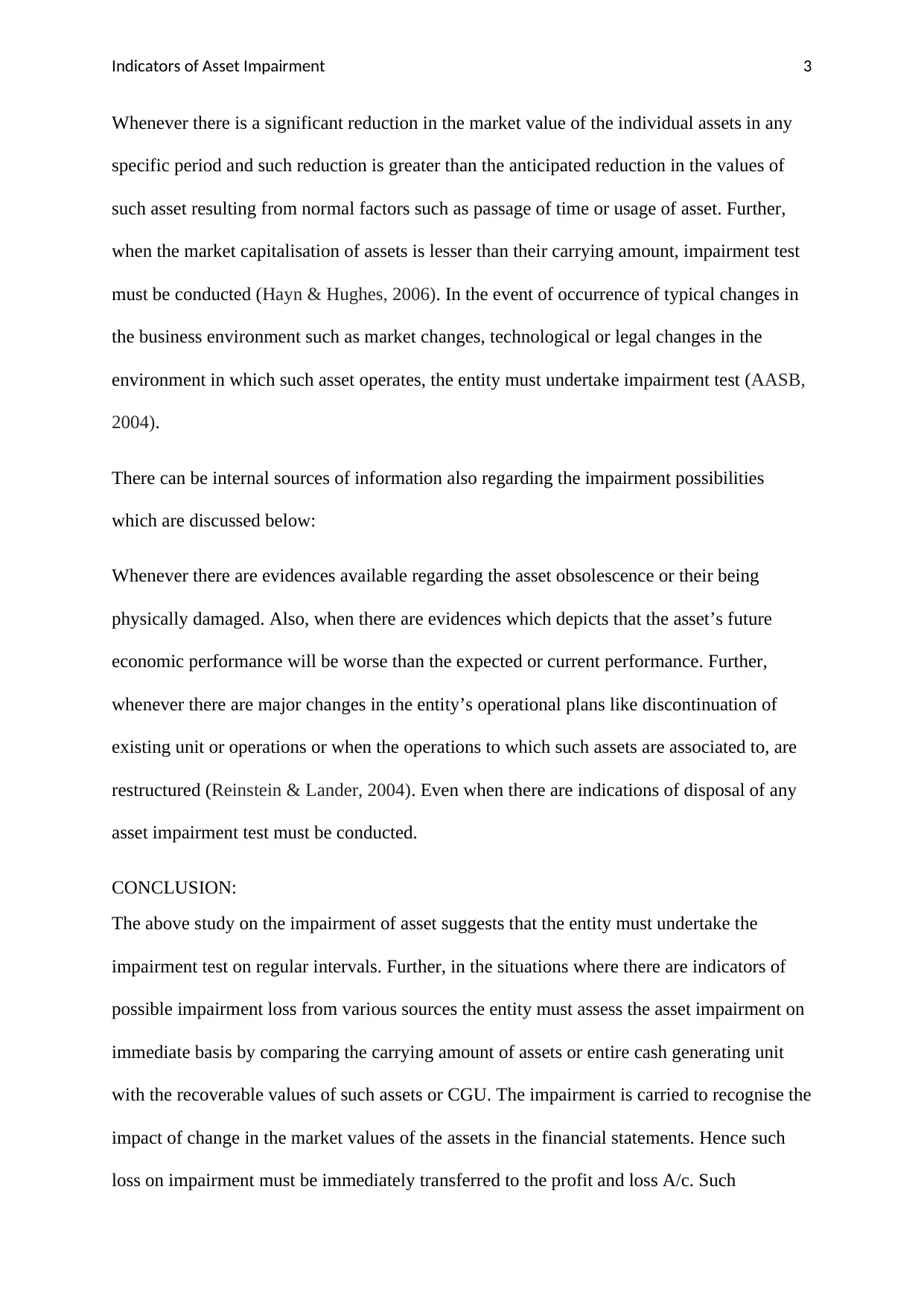
Indicators of Asset Impairment 3
Whenever there is a significant reduction in the market value of the individual assets in any
specific period and such reduction is greater than the anticipated reduction in the values of
such asset resulting from normal factors such as passage of time or usage of asset. Further,
when the market capitalisation of assets is lesser than their carrying amount, impairment test
must be conducted (Hayn & Hughes, 2006). In the event of occurrence of typical changes in
the business environment such as market changes, technological or legal changes in the
environment in which such asset operates, the entity must undertake impairment test (AASB,
2004).
There can be internal sources of information also regarding the impairment possibilities
which are discussed below:
Whenever there are evidences available regarding the asset obsolescence or their being
physically damaged. Also, when there are evidences which depicts that the asset’s future
economic performance will be worse than the expected or current performance. Further,
whenever there are major changes in the entity’s operational plans like discontinuation of
existing unit or operations or when the operations to which such assets are associated to, are
restructured (Reinstein & Lander, 2004). Even when there are indications of disposal of any
asset impairment test must be conducted.
CONCLUSION:
The above study on the impairment of asset suggests that the entity must undertake the
impairment test on regular intervals. Further, in the situations where there are indicators of
possible impairment loss from various sources the entity must assess the asset impairment on
immediate basis by comparing the carrying amount of assets or entire cash generating unit
with the recoverable values of such assets or CGU. The impairment is carried to recognise the
impact of change in the market values of the assets in the financial statements. Hence such
loss on impairment must be immediately transferred to the profit and loss A/c. Such
Whenever there is a significant reduction in the market value of the individual assets in any
specific period and such reduction is greater than the anticipated reduction in the values of
such asset resulting from normal factors such as passage of time or usage of asset. Further,
when the market capitalisation of assets is lesser than their carrying amount, impairment test
must be conducted (Hayn & Hughes, 2006). In the event of occurrence of typical changes in
the business environment such as market changes, technological or legal changes in the
environment in which such asset operates, the entity must undertake impairment test (AASB,
2004).
There can be internal sources of information also regarding the impairment possibilities
which are discussed below:
Whenever there are evidences available regarding the asset obsolescence or their being
physically damaged. Also, when there are evidences which depicts that the asset’s future
economic performance will be worse than the expected or current performance. Further,
whenever there are major changes in the entity’s operational plans like discontinuation of
existing unit or operations or when the operations to which such assets are associated to, are
restructured (Reinstein & Lander, 2004). Even when there are indications of disposal of any
asset impairment test must be conducted.
CONCLUSION:
The above study on the impairment of asset suggests that the entity must undertake the
impairment test on regular intervals. Further, in the situations where there are indicators of
possible impairment loss from various sources the entity must assess the asset impairment on
immediate basis by comparing the carrying amount of assets or entire cash generating unit
with the recoverable values of such assets or CGU. The impairment is carried to recognise the
impact of change in the market values of the assets in the financial statements. Hence such
loss on impairment must be immediately transferred to the profit and loss A/c. Such
Paraphrase This Document
Need a fresh take? Get an instant paraphrase of this document with our AI Paraphraser
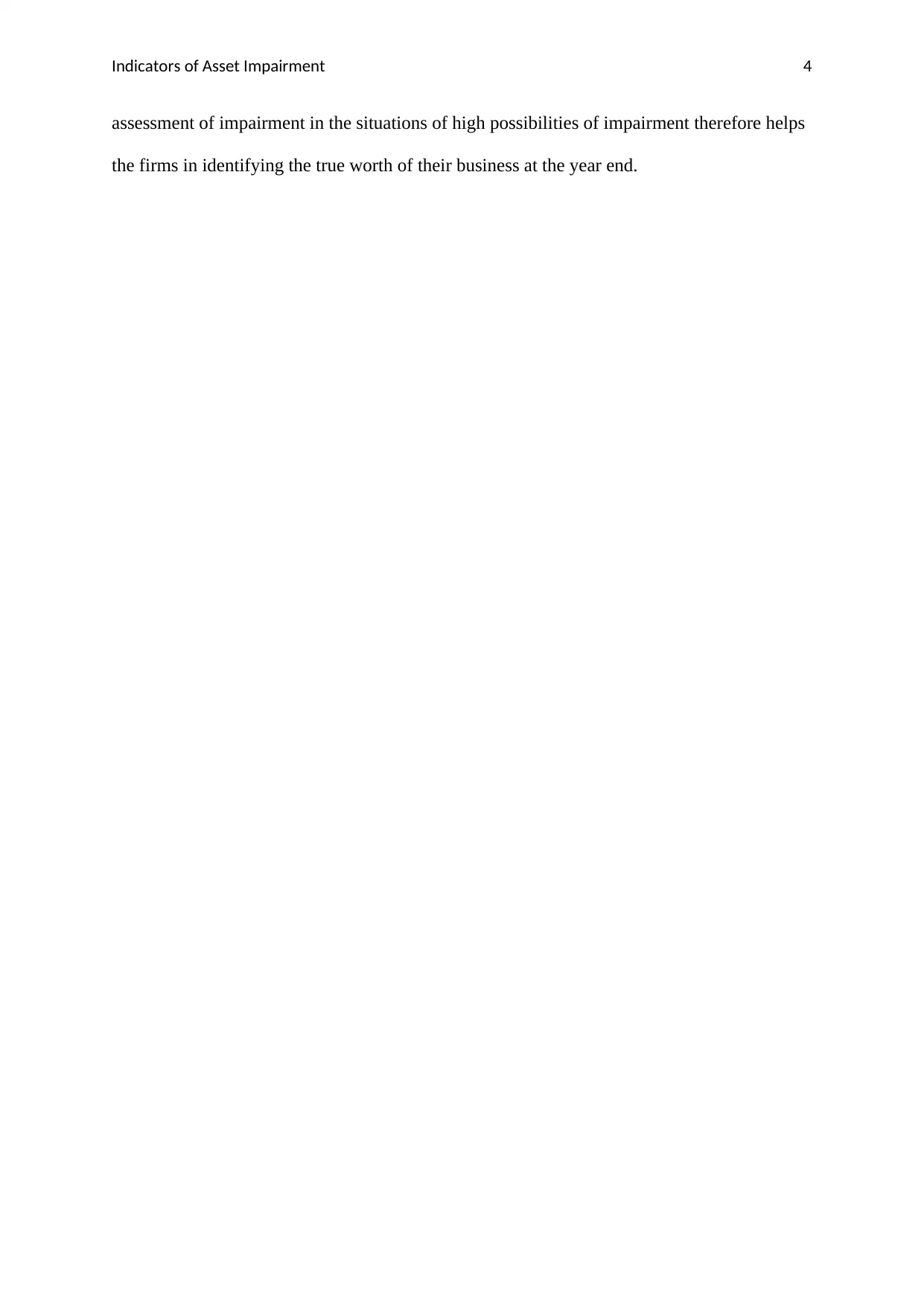
Indicators of Asset Impairment 4
assessment of impairment in the situations of high possibilities of impairment therefore helps
the firms in identifying the true worth of their business at the year end.
assessment of impairment in the situations of high possibilities of impairment therefore helps
the firms in identifying the true worth of their business at the year end.
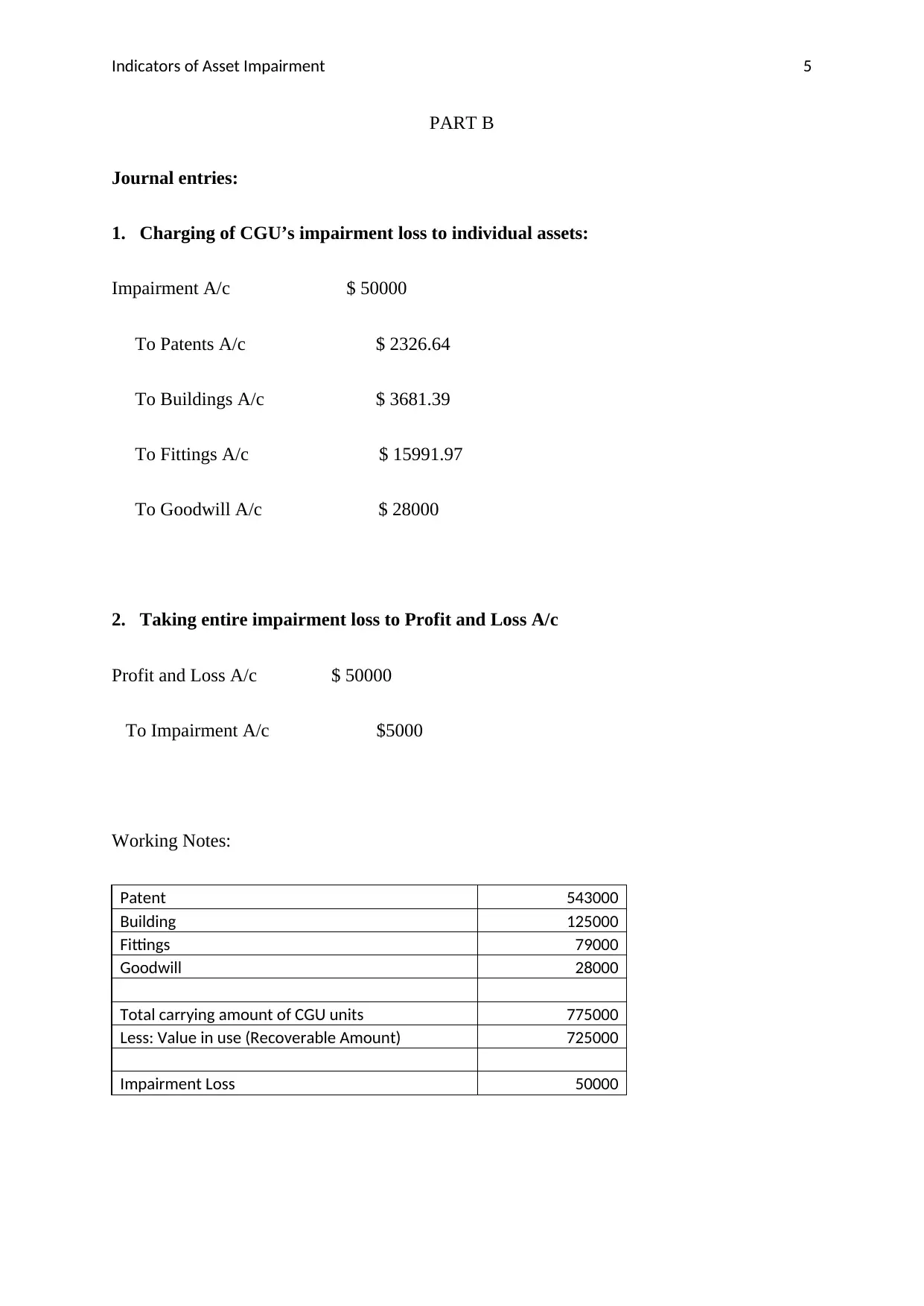
Indicators of Asset Impairment 5
PART B
Journal entries:
1. Charging of CGU’s impairment loss to individual assets:
Impairment A/c $ 50000
To Patents A/c $ 2326.64
To Buildings A/c $ 3681.39
To Fittings A/c $ 15991.97
To Goodwill A/c $ 28000
2. Taking entire impairment loss to Profit and Loss A/c
Profit and Loss A/c $ 50000
To Impairment A/c $5000
Working Notes:
Patent 543000
Building 125000
Fittings 79000
Goodwill 28000
Total carrying amount of CGU units 775000
Less: Value in use (Recoverable Amount) 725000
Impairment Loss 50000
PART B
Journal entries:
1. Charging of CGU’s impairment loss to individual assets:
Impairment A/c $ 50000
To Patents A/c $ 2326.64
To Buildings A/c $ 3681.39
To Fittings A/c $ 15991.97
To Goodwill A/c $ 28000
2. Taking entire impairment loss to Profit and Loss A/c
Profit and Loss A/c $ 50000
To Impairment A/c $5000
Working Notes:
Patent 543000
Building 125000
Fittings 79000
Goodwill 28000
Total carrying amount of CGU units 775000
Less: Value in use (Recoverable Amount) 725000
Impairment Loss 50000
⊘ This is a preview!⊘
Do you want full access?
Subscribe today to unlock all pages.

Trusted by 1+ million students worldwide
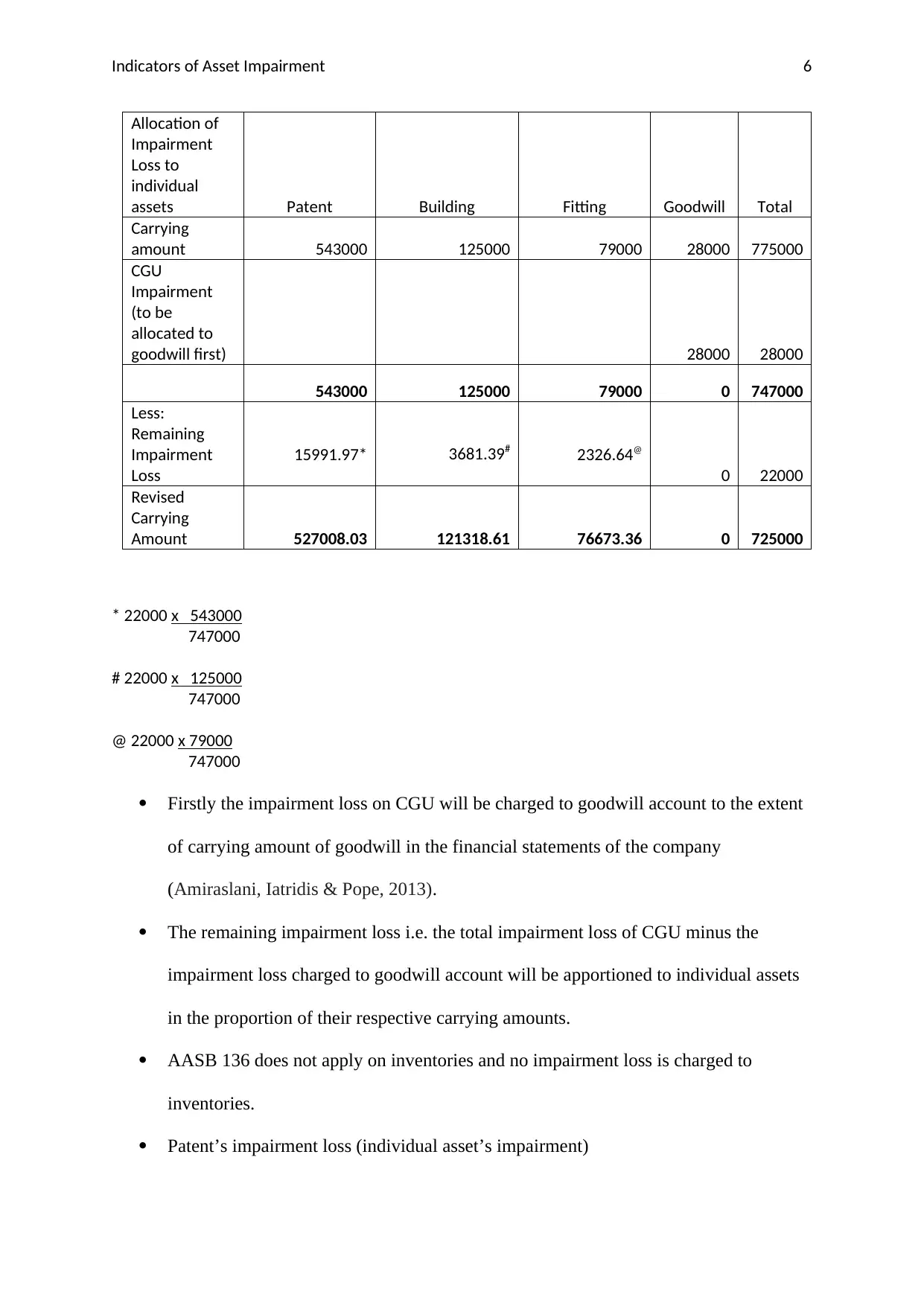
Indicators of Asset Impairment 6
Allocation of
Impairment
Loss to
individual
assets Patent Building Fitting Goodwill Total
Carrying
amount 543000 125000 79000 28000 775000
CGU
Impairment
(to be
allocated to
goodwill first) 28000 28000
543000 125000 79000 0 747000
Less:
Remaining
Impairment
Loss
15991.97* 3681.39# 2326.64@
0 22000
Revised
Carrying
Amount 527008.03 121318.61 76673.36 0 725000
* 22000 x 543000
747000
# 22000 x 125000
747000
@ 22000 x 79000
747000
Firstly the impairment loss on CGU will be charged to goodwill account to the extent
of carrying amount of goodwill in the financial statements of the company
(Amiraslani, Iatridis & Pope, 2013).
The remaining impairment loss i.e. the total impairment loss of CGU minus the
impairment loss charged to goodwill account will be apportioned to individual assets
in the proportion of their respective carrying amounts.
AASB 136 does not apply on inventories and no impairment loss is charged to
inventories.
Patent’s impairment loss (individual asset’s impairment)
Allocation of
Impairment
Loss to
individual
assets Patent Building Fitting Goodwill Total
Carrying
amount 543000 125000 79000 28000 775000
CGU
Impairment
(to be
allocated to
goodwill first) 28000 28000
543000 125000 79000 0 747000
Less:
Remaining
Impairment
Loss
15991.97* 3681.39# 2326.64@
0 22000
Revised
Carrying
Amount 527008.03 121318.61 76673.36 0 725000
* 22000 x 543000
747000
# 22000 x 125000
747000
@ 22000 x 79000
747000
Firstly the impairment loss on CGU will be charged to goodwill account to the extent
of carrying amount of goodwill in the financial statements of the company
(Amiraslani, Iatridis & Pope, 2013).
The remaining impairment loss i.e. the total impairment loss of CGU minus the
impairment loss charged to goodwill account will be apportioned to individual assets
in the proportion of their respective carrying amounts.
AASB 136 does not apply on inventories and no impairment loss is charged to
inventories.
Patent’s impairment loss (individual asset’s impairment)
Paraphrase This Document
Need a fresh take? Get an instant paraphrase of this document with our AI Paraphraser
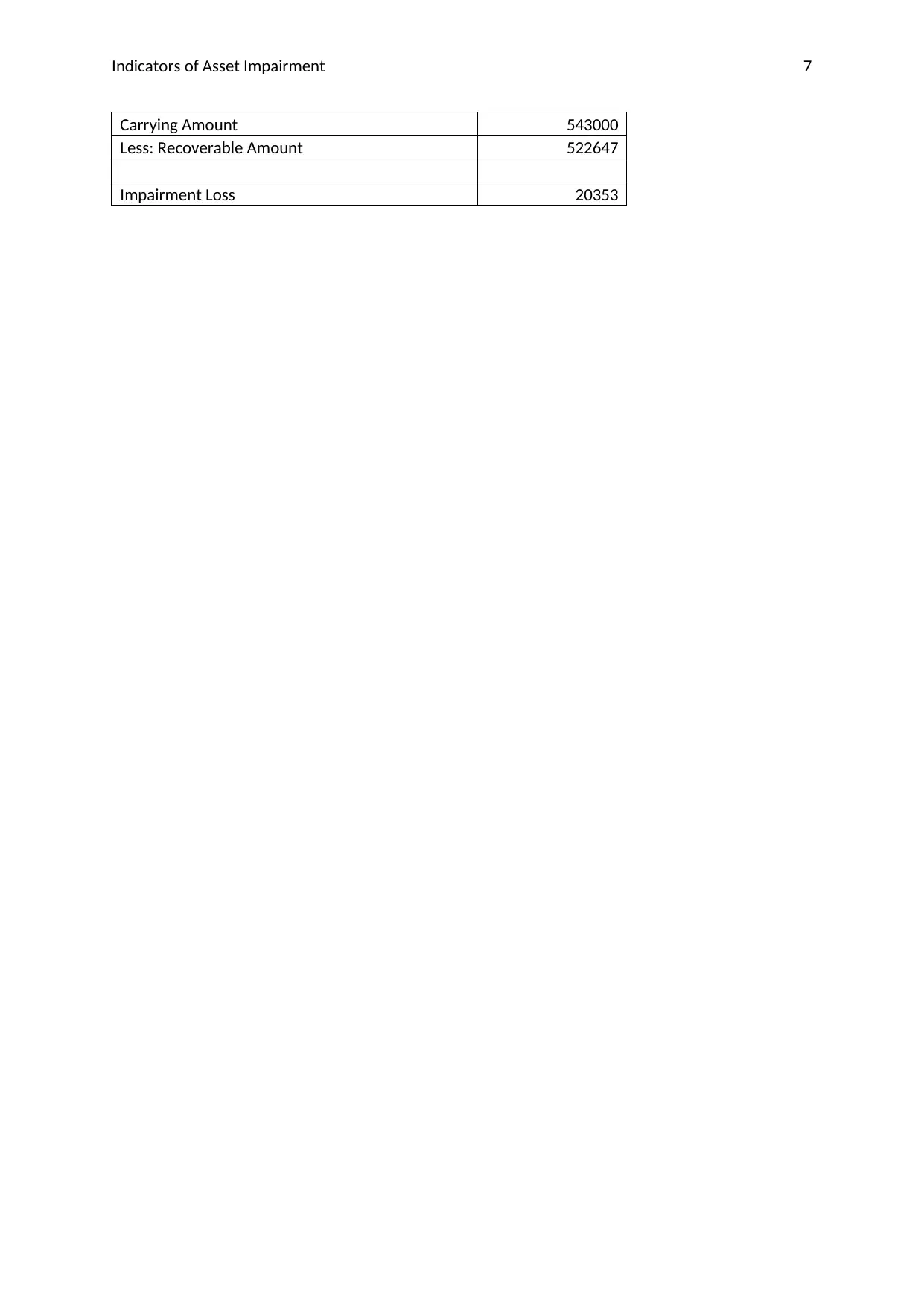
Indicators of Asset Impairment 7
Carrying Amount 543000
Less: Recoverable Amount 522647
Impairment Loss 20353
Carrying Amount 543000
Less: Recoverable Amount 522647
Impairment Loss 20353
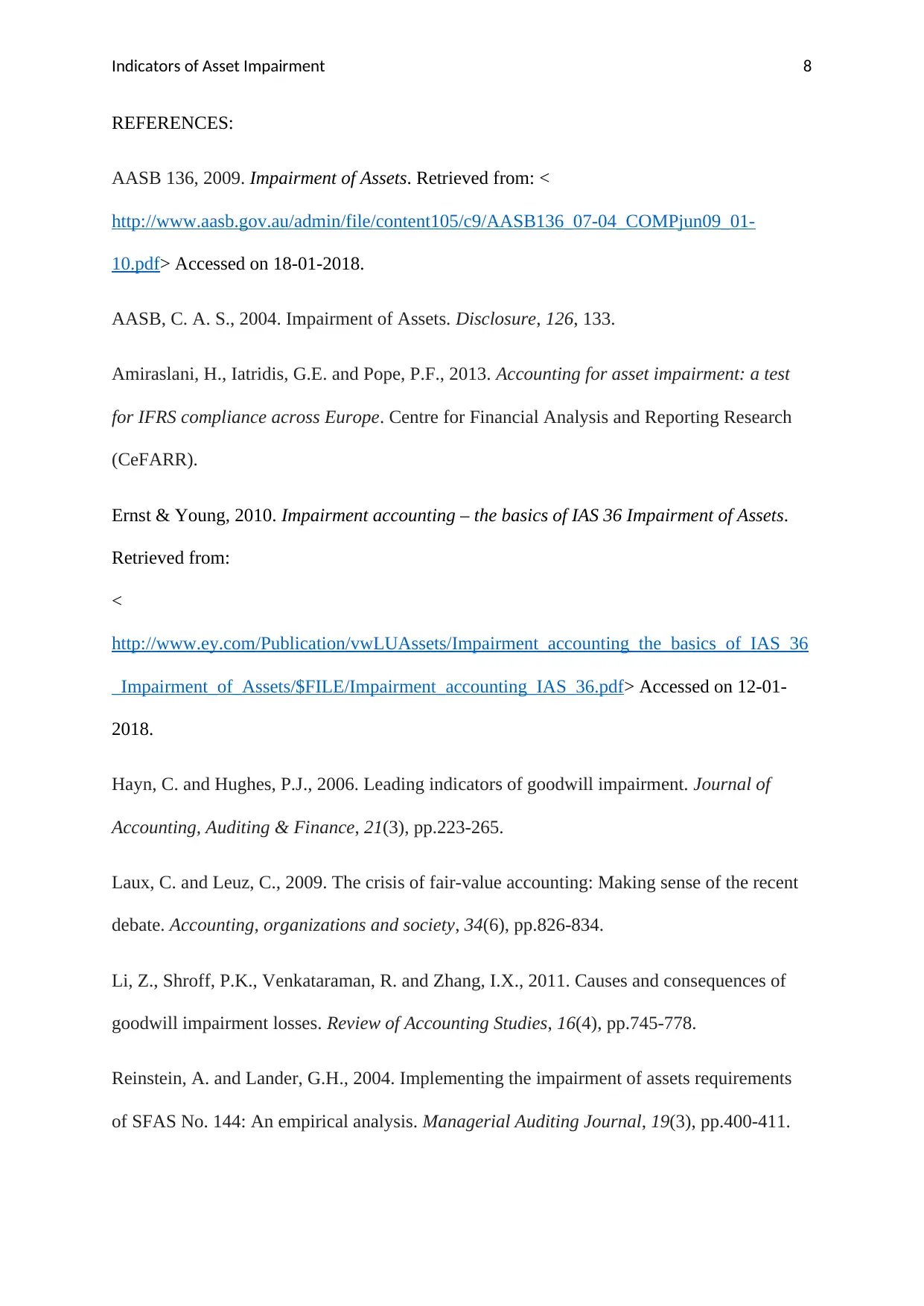
Indicators of Asset Impairment 8
REFERENCES:
AASB 136, 2009. Impairment of Assets. Retrieved from: <
http://www.aasb.gov.au/admin/file/content105/c9/AASB136_07-04_COMPjun09_01-
10.pdf> Accessed on 18-01-2018.
AASB, C. A. S., 2004. Impairment of Assets. Disclosure, 126, 133.
Amiraslani, H., Iatridis, G.E. and Pope, P.F., 2013. Accounting for asset impairment: a test
for IFRS compliance across Europe. Centre for Financial Analysis and Reporting Research
(CeFARR).
Ernst & Young, 2010. Impairment accounting – the basics of IAS 36 Impairment of Assets.
Retrieved from:
<
http://www.ey.com/Publication/vwLUAssets/Impairment_accounting_the_basics_of_IAS_36
_Impairment_of_Assets/$FILE/Impairment_accounting_IAS_36.pdf> Accessed on 12-01-
2018.
Hayn, C. and Hughes, P.J., 2006. Leading indicators of goodwill impairment. Journal of
Accounting, Auditing & Finance, 21(3), pp.223-265.
Laux, C. and Leuz, C., 2009. The crisis of fair-value accounting: Making sense of the recent
debate. Accounting, organizations and society, 34(6), pp.826-834.
Li, Z., Shroff, P.K., Venkataraman, R. and Zhang, I.X., 2011. Causes and consequences of
goodwill impairment losses. Review of Accounting Studies, 16(4), pp.745-778.
Reinstein, A. and Lander, G.H., 2004. Implementing the impairment of assets requirements
of SFAS No. 144: An empirical analysis. Managerial Auditing Journal, 19(3), pp.400-411.
REFERENCES:
AASB 136, 2009. Impairment of Assets. Retrieved from: <
http://www.aasb.gov.au/admin/file/content105/c9/AASB136_07-04_COMPjun09_01-
10.pdf> Accessed on 18-01-2018.
AASB, C. A. S., 2004. Impairment of Assets. Disclosure, 126, 133.
Amiraslani, H., Iatridis, G.E. and Pope, P.F., 2013. Accounting for asset impairment: a test
for IFRS compliance across Europe. Centre for Financial Analysis and Reporting Research
(CeFARR).
Ernst & Young, 2010. Impairment accounting – the basics of IAS 36 Impairment of Assets.
Retrieved from:
<
http://www.ey.com/Publication/vwLUAssets/Impairment_accounting_the_basics_of_IAS_36
_Impairment_of_Assets/$FILE/Impairment_accounting_IAS_36.pdf> Accessed on 12-01-
2018.
Hayn, C. and Hughes, P.J., 2006. Leading indicators of goodwill impairment. Journal of
Accounting, Auditing & Finance, 21(3), pp.223-265.
Laux, C. and Leuz, C., 2009. The crisis of fair-value accounting: Making sense of the recent
debate. Accounting, organizations and society, 34(6), pp.826-834.
Li, Z., Shroff, P.K., Venkataraman, R. and Zhang, I.X., 2011. Causes and consequences of
goodwill impairment losses. Review of Accounting Studies, 16(4), pp.745-778.
Reinstein, A. and Lander, G.H., 2004. Implementing the impairment of assets requirements
of SFAS No. 144: An empirical analysis. Managerial Auditing Journal, 19(3), pp.400-411.
⊘ This is a preview!⊘
Do you want full access?
Subscribe today to unlock all pages.

Trusted by 1+ million students worldwide
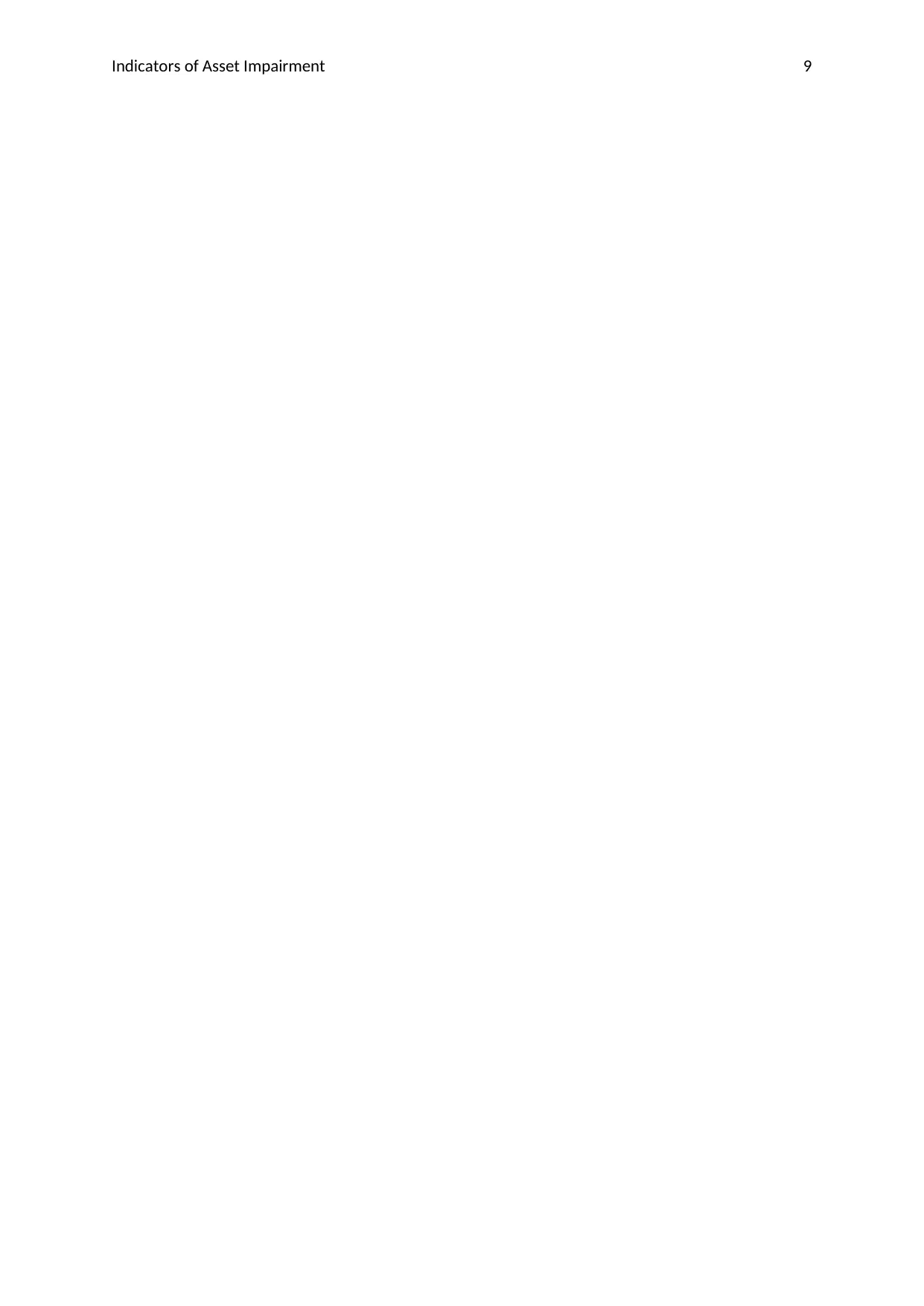
Indicators of Asset Impairment 9
1 out of 10
Related Documents
Your All-in-One AI-Powered Toolkit for Academic Success.
+13062052269
info@desklib.com
Available 24*7 on WhatsApp / Email
![[object Object]](/_next/static/media/star-bottom.7253800d.svg)
Unlock your academic potential
Copyright © 2020–2025 A2Z Services. All Rights Reserved. Developed and managed by ZUCOL.





